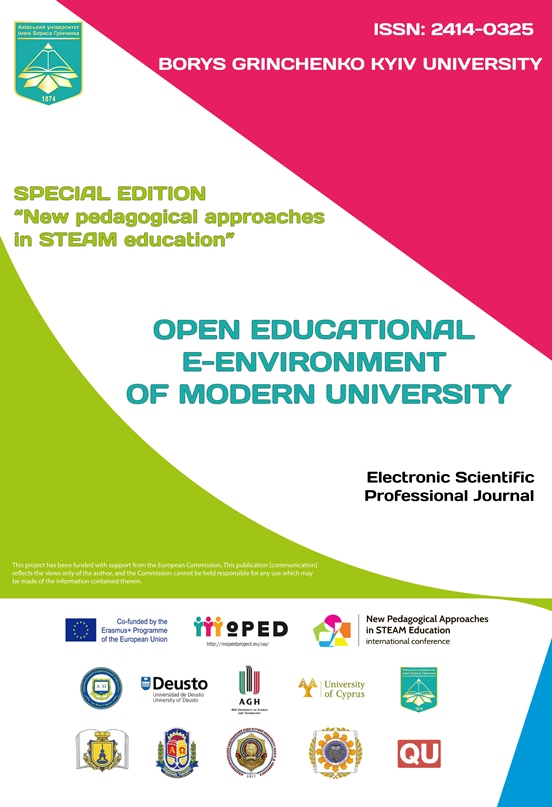USE OF MOBILE DEVICE SENSORS TO CONDUCT THE PHYSICAL EXPERIMENT
DOI:
https://doi.org/10.28925/2414-0325.2019s31Keywords:
mobile learning, mobile devices, sensors, measurement of physical quantities, Google Science Journal, physical experiment, STEM educationAbstract
The concept of "sensor" in the system of physical experiment at school is considered in the article. The possibility of using sensors in physics lessons is substantiated: transformation of an input signal into an output is accompanied by transformation of one type of energy into another (according to the law of conservation of energy), and the functioning of the sensors are based on physical phenomena (physical effects or principles), which are described by the relevant physical laws. The article deals with the methodical aspects of using the Google Science Journal mobile application in physics lessons. This application allows you to use the sensors of your mobile device for a physical experiment. As an example we consider the frontal laboratory work "Determination of the period of oscillation of the mathematical pendulum". The method of its carrying out is offered in two approaches: the first one involves the traditional technique of conducting the experiment, and the second approach is using the mobile application Google Science Journal. The article shows that the use of smartphone sensors in physics lessons has perspectives in the context of STEM education. Thus, the use of the considered application is of current importance and requires further scientific and methodological research on its use in the high school physical experimentation system. The Science Journal mobile application can be used to connect external sensors, which will have a positive impact on the introduction of STEM education, and to use Arduino in the demonstration of physical experiments by a physics teacher. Connecting sensors using an Arduino microcontroller is particularly promising in creative lab work on physics.
Downloads
References
Bar'jakhtar, V. Gh. & Bozhynova F.Ja. (2010). Physics. Grade 10. Academic level: Tutorial for general education. teach establishments H: Publishing House «Ranok», 256 p. (in Ukrainian)
Bykov, V. Ju. (2013). Mobile space and mobile-oriented Internet environment: features of model presentation and educational application. Informacijni tekhnologhiji i zasoby navchannja, 17, 9–37. (in Ukrainian)
Borysenko, D.V. (2018). Using mobile applications when designing a product design for future design professionals. Informacijni tekhnologhiji i zasoby navchannja, Vol. 68, 6, 47–63. (in Ukrainian)
Velychko, S.P., Saljnyk, I.V. & Siryk E.P. (2015). Integrated learning experiment on quantum optics and atomic physics. A guide for teachers and students of pedagogy. higher educators establishments. Kirovoghrad: COP «Avanghard», 92 p. (in Ukrainian)
Velychko, S.P. & Shuljgha, S.V. (2018). Computer-oriented means of supporting students' independent activity in the training of quantum physics. Informacijni tekhnologhiji i zasoby navchannja, Vol. 65, 3, 103-114 (in Ukrainian)
Measuring transducers (sensors) (2015). A textbook. V. M. Vanjko, Je. S. Polishhuk, M. M. Dorozhovecj, V.O. Jacuk, Ju. V. Jacuk; edit: Je. S. Polishhuk, V. M. Vanjko; University «Ljviv. politekhnika», Lviv, 580 p. (in Ukrainian)
Gholovko, M.V. (2015). The Genesis of the Implementation of Information and Communication Technologies in Physical Education: from Computer-Aided Learning to the Formation of Key and Subjective Competencies. Informacijni tekhnologhiji i zasoby navchannja, Vol. 45, 1, 1–11 (in Ukrainian)
Sensors: Reference Guide (2012). Under total ed. V.M. Sharapova, E.S. Polyshhuka. Moscow: Technosphere, 624 p. (in Russian)
Encyklopedija kibernetyky (1973). U 2-kh tomakh. K.: Ghol. red. URE; T. 1. 584 p.; T. 2. 574 p. (in Ukrainian)
Kyslova, M.A., Semerikov S.O. & Slovak K.I. (2014). Development of the mobile learning environment as a problem of theory and methodology of using information and communication technologies in education. Informacijni tekhnologhiji i zasoby navchannja, Vol. 42, 4, 1–19. (in Ukrainian)
Kotjuk, A.F. (2006). Sensors in modern dimensions. M.: Radyo y svjazj, 96p. (in Russian)
Lavrova, A.V. & Zabolotnyj, V.F. (2015). Approach to organizing and conducting a school physical physical experiment. Informacijni tekhnologhiji i zasoby navchannja, Vol. 50, 6, 57–70. (in Ukrainian)
Metrological terminology. Does the sensor have a sensor? Metrology and Instruments (2008). Number 2, 59–64. (in Ukrainian)
Morze, N.V., Gladun, M.A. & Dzjuba, S.M. (2018). Formation of key and subject competences of students by robotic means of STEM-education. Informacijni tekhnologhiji i zasoby navchannja, Vol. 65, 3, 37–52. (in Ukrainian)
Russian-Ukrainian dictionary (2003). 160,000 words. Compilers: I.O. Annina, Gh.N. Ghorjushyna, I.S. Ghnatjuk etc.; Ed. Dr. philol. Sciences, prof. V.V. Zhajvoronka. K.: Abrys, 1404.
Saljnyk, I.V. (2016). Integration of real and virtual learning physical experiment in high school. (Avtoreferat dysertatsii doktora pedagogichny`x nauk). National Pedagogical University named after M.P. Dragomanov, Kyiv. (in Ukrainian)
Safarov, Gh. (2013). Sensors and sensors of modern mobile devices. https://infocity.az/2013/07/датчики и сенсоры/ (in Russian)
Stryzhak, O.Je., Slipukhina, I.A., Polisun, N.I. & Chernecjkyj, I.S. (2017). STEM education: basic definitions. Informacijni tekhnologhiji i zasoby navchannja, Vol. 62, 6, 16–33. (in Ukrainian)
Strjuk, M.I., Semerikov, S.O. & Strjuk, A.M. (2015). Mobility: A Systemic Approach. Informacijni tekhnologhiji i zasoby navchannja. Vol. 49, 5. 37–70. (in Ukrainian)
Keyes, C., Shroff, R. H. & Linger W. (2019). Addressing Design Issues In Mobile Applications Supporting Ubiquitous Learning
chrome-extension://oemmndcbldboiebfnladdacbdfmadadm/https://repository.hkbu.edu. hk/cgi/viewcontent.cgi
Google and Arduino introduced the Arduino Science Physical Laboratory Kit (2019). https://www.cnx-software.com













1.jpg)








